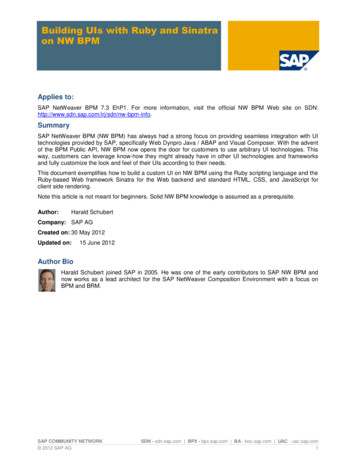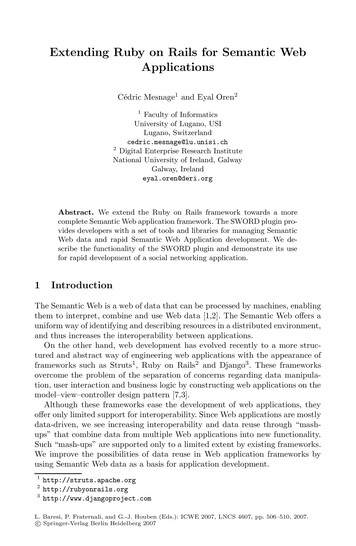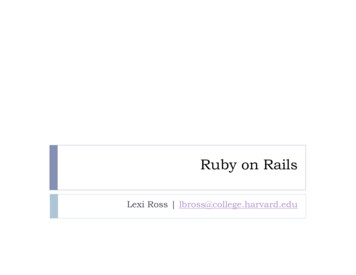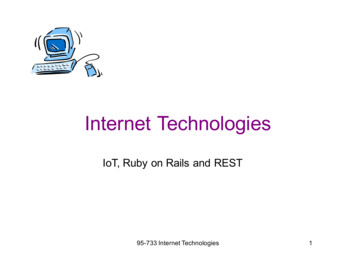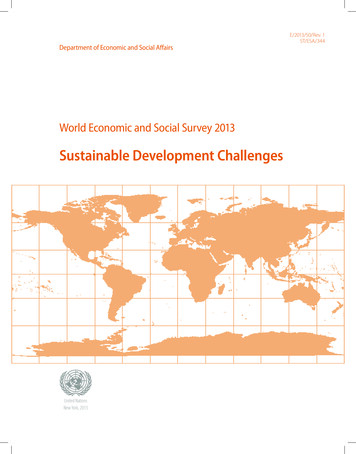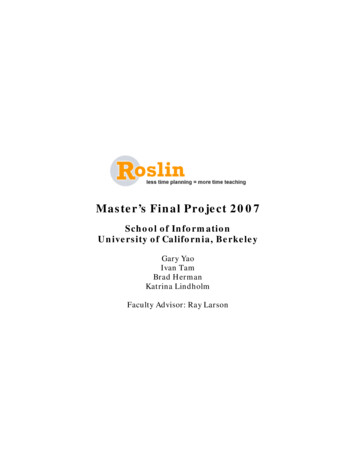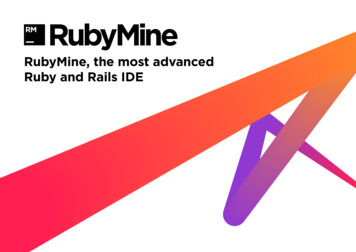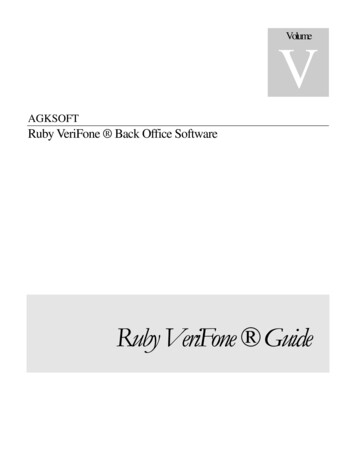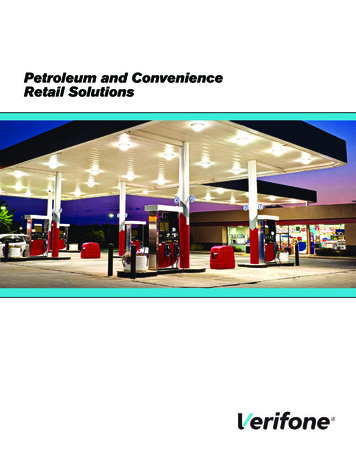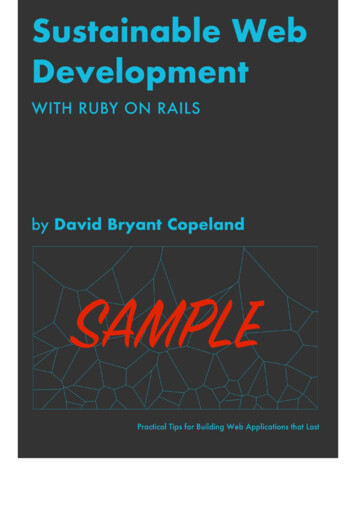
Transcription
Sustainable Web Developmentwith Ruby on RailsPractical Tips for Building Web Applications that LastDavid Bryant Copeland
This sample is copyright 2020 by David Bryant Copeland, All RightsReserved.For more information, visit https://sustainable-rails.com
ContentsContentsAcknowledgementsI1Introduction1 Why This Book Exists1.1 What is Sustainability? . . . . . . . . . . . . . . . . . . .1.2 Why Care About Sustainability? . . . . . . . . . . . . . .1.3 How to Value Sustainability . . . . . . . . . . . . . . . .1.4 Assumptions . . . . . . . . . . . . . . . . . . . . . . . . .1.4.1 The Software Has a Clear Purpose . . . . . . . .1.4.2 The Software Needs To Exist For Years . . . . . .1.4.3 The Software Will Evolve . . . . . . . . . . . . .1.4.4 The Team Will Change . . . . . . . . . . . . . . .1.4.5 You Value Sustainability, Consistency, and Quality1.5 Opportunity and Carrying Costs . . . . . . . . . . . . . .1.6 Why should you trust me? . . . . . . . . . . . . . . . . .556688999911122 Business Logic (Does Not Go in Active Records)2.1 Business Logic Makes Your App Special. . . and Complex . . .2.1.1 Business Logic is a Magnet for Complexity . . . . . .2.1.2 Business Logic Experiences Churn . . . . . . . . . . .2.2 Bugs in Commonly-Used Classes Have Wide Effects . . . . .2.3 Business Logic in Active Records Puts Churn and Complexityin Critical Classes . . . . . . . . . . . . . . . . . . . . . . . .2.4 Example Design of a Feature . . . . . . . . . . . . . . . . . .15161616173 Jobs3.1 Use Jobs To Defer Execution or Increase Fault-Tolerance . .3.1.1 Web Workers, Worker Pools, Memory, and ComputePower . . . . . . . . . . . . . . . . . . . . . . . . . .3.1.2 Network Calls and Third Parties are Slow . . . . . .3.1.3 Network Calls and Third Parties are Flaky . . . . . .3.1.4 Use Background Jobs Only When Needed . . . . . .3.2 Understand How Your Job Backend Works . . . . . . . . . .3.2.1 Understand Where and How Jobs (and their Arguments) are Queued . . . . . . . . . . . . . . . . . . .29291922303031323334
3.33.43.53.63.2.2 Understand What Happens When a Job Fails . . . . .3.2.3 Observe the Behavior of Your Job Backend . . . . . .Sidekiq is The Best Job Backend for Most Teams . . . . . . .Queue Jobs Directly, and Have Them Defer to Your BusinessLogic Code . . . . . . . . . . . . . . . . . . . . . . . . . . .3.4.1 Do Not Use Active Job - Use the Job Backend Directly3.4.2 Job Code Should Defer to Your Service Layer . . . .Job Testing Strategies . . . . . . . . . . . . . . . . . . . . .Jobs Will Get Retried and Must Be Idempotent . . . . . . . .3435353939414346
AcknowledgementsIf there were no such thing as Rails, this book would be, well, pretty strange.So I must acknowledge and deeply thank DHH and the Rails core team forbuilding and maintaining such a wonderful framework for all of us to use.I have to thank my wife, Amy, who gave me the space and encouragementto work on this. During a global pandemic. When both of us were brieflyout of work. And we realized our aging parents require more care than wethought. And when we got two kittens named Carlos Rosario and Zoni. Andwhen we bought a freaking car. And when I joined a pre-seed startup. It’sbeen quite a time.I also want to thank the technical reviewers, Noel Rappin, Chris Gibson,Zach Campbell, Lisa Sheridan, Raul Murciano, Geoff The, and Sean Miller.1
PARTIintroduction
1Why This Book ExistsRails can scale. But what does that actually mean? And how do we do it?This book is the answer to both of these questions, but instead of using“scalable”, which many developers equate with “fast performance”, I’m usingthe word “sustainable”. This is really what we want out of our software: theability to sustain that software over time.Rails itself is an important component in sustainable web development,since it provides common solutions to common problems and has reached asignificant level of maturity. But it’s not the complete picture.Rails has a lot of features and we may not need them all. Or, we mayneed to take some care in how we use them. Rails also leaves gaps in yourapplication’s architecture that you’ll have to fill (which makes sense, sinceRails can’t possibly provide everything your app will need).This book will help you navigate all of that.Before we begin, I want to be clear about what sustainability means andwhy it’s important. I also want to state the assumptions I’m making inwriting this, because there is no such thing as universal advice—there’s onlyrecommendations that apply in a given context.1.1What is Sustainability?The literal interpretation of sustainable web development is web development that can be sustained. As silly as that definition is, I find it anilluminating restatement.To sustain the development of our software is to ensure that it can continueto meet its needs. A sustainable web app can easily suffer new requirements,increased demand for its resources, and an increasing (or changing) teamof developers to maintain it.A system that is hard to change is hard to sustain. A system that can’t availitself of the resources it needs to function is hard to sustain. A system thatonly some developers can work on is hard to sustain.Thus, a sustainable application is one in which changes we make tomorroware as easy as changes are today, for whatever the application might need todo and whoever might be tasked with working on it.5
So this defines sustainability, but why is it important?1.2Why Care About Sustainability?Most software exists to meet some need, and if that need will persist overtime, so must the software. Needs are subjective and vague, while softwaremust be objective and specific. Thus, building software is often a matterof continued refinement as the needs are slowly clarified. And, of course,needs have a habit of changing along the way.Software is expensive, mostly owing to the expertise required to build andmaintain it. People who can write software find their skills to be in highdemand, garnering some of the highest wages in the world, even at entrylevels. It stands to reason that if a piece of software requires more effort toenhance and maintain over time, it will cost more and more and deliver lessand less.In an economic sense, sustainable software minimizes the cost of the software over time. But there is a human cost to working on software. Workingon sustainable software is, well, more enjoyable. They say employees quitmanagers, but I’ve known developers that quit codebases. Working onunsustainable software just plain sucks, and I think there’s value in having ajob that doesn’t suck. . . at least not all of the time.Of course, it’s one thing to care about sustainability in the abstract, but howdoes that translate into action?1.3How to Value SustainabilitySustainability is like an investment. It necessarily won’t pay off in the shortterm and, if the investment isn’t sound, it won’t ever pay off. So it’s reallyimportant to understand the value of sustainability to your given situationand to have access to as much information as possible to know exactly howto invest in it.Predicting the future is dangerous for programmers. It can lead to overengineering, which makes certain classes of changes more difficult in thefuture. To combat this urge, developers often look to the tenets of agilesoftware development, which have many cute aphorisms that boil down to“don’t build software that you don’t know you need”.If you are a hired consultant, this is excellent advice. It gives you a framework to be successful and manage change when you are in a situation whereyou have very little access to information. The strategy of “build for onlywhat you 100% know you need” works great to get software shipped withconfidence, but it doesn’t necessarily lead to a sustainable outcome.For example, no business person is going to ask you to write log statementsso you can understand your code in production. No product owner is going6
to ask you to create a design system to facilitate building user interfacesmore quickly. And no one is going to require that your database havereferential integrity.The features of the software are merely one input into what software getsbuilt. They are a significant one just not the only one. To make bettertechnical decisions, you need access to more information than simply whatsomeone wants the software to do.Do you know what economic or behavioral output the software exists toproduce? In other words, how does the software make money for the peoplepaying you to write it? What improvements to the business is it expected tomake? What is the medium or long-term plan for the business? Does it needto grow significantly? Will there need to be increased traffic? Will there bean influx of engineers? Will they be very senior, very junior, or a mix? Whenwill they be hired and when will they start?The more information you can get access to the better, because all of thisfeeds into your technical decision-making and can tell you just how sustainable your app needs to be. If there will be an influx of less experienceddevelopers, you might make different decisions than if the team is onlyhiring one or two experienced specialists.Armed with this sort of information, you can make technical decisions aspart of an overall strategy. For example, you may want to spend severaldays setting up a more sustainable development environment. By pointingto the company’s growth projections and your teams hiring plans, that workcan be easily justified (see the sidebar “Understanding Growth At Stitch Fix”on the next page for a specific example of this).If you don’t have the information about the business, the team, or anythingother than what some user wants the software to do, you aren’t set up to dosustainable development. But it doesn’t mean you shouldn’t ask anyway.People who don’t have experience writing software won’t necessarily intuitthat such information is relevant, so they might not be forthcoming. Butyou’d be surprised just how much information you can get from someone byasking.Whatever the answers are, you can use this as part of an overall technicalstrategy, of which sustainability is a part. As you read this book, I’ll talk aboutthe considerations around the various recommendations and techniques.They might not all apply to your situation, but many of them will.Which brings us to the set of assumptions that this book is based on. Inother words, what is the situation in which sustainability is important andin which this book’s recommendations apply?7
Understanding Growth At Stitch FixDuring my first few months at Stitch Fix, I was asked to help improve theoperations of our warehouse. There were many different processes and wehad a good sense of which ones to start automating. At the time, there wasonly one application—called H ELLBLAZER—and it served up stitchfix.com.If I hadn’t been told anything else, the simplest thing to do would’vebeen to make a /warehouse route in H ELLBLAZER and slowly add featuresfor the associates there. But I had been told something else.Like almost everyone at the company, the engineering team was told—very transparently—what the growth plans for the business were. It neededto grow in a certain way or the business would fail. It was easy to extrapolatefrom there what that would mean for the size of the engineering team, andfor the significance of the warehouse’s efficiency. It was clear that a singlecodebase everyone worked in would be a nightmare, and migrating awayfrom it later would be difficult and expensive.So, we created a new application that shared H ELLBLAZER’s database.It would’ve certainly been faster to add code to H ELLBLAZER directly, butwe knew doing so would burn us long-term. As the company grew, thedevelopers working on warehouse software were fairly isolated since theyworked in a totally different codebase. We replicated this pattern and, aftersix years of growth, it was clearly the right decision, even accounting forproblems that happen when you share a database between apps.We never could’ve known that without a full understanding of the company’s growth plans, and long-term vision for the problems we were thereto solve.1.4AssumptionsThis book is pretty prescriptive, but each prescription comes with an explanation, and all of the book’s recommendations are based on some keyassumptions that I would like to state explicitly. If your situation differswildly from the one described below, you might not get that much out of thisbook. My hope—and belief—is that the assumptions below are common,and that the situation of writing software that you find yourself in is similarto situations I have faced. Thus, this book will help you.In case it’s not, I want to state my assumptions up front, right here in thisfree chapter.1.4.1The Software Has a Clear PurposeThis might seem like nonsense, but there are times when we don’t exactlyknow what the software is solving for, yet need to write some software toexplore the problem space.8
Perhaps some venture capitalist has given us some money, but we don’tyet know the exact market for our solution. Maybe we’re prototyping apotentially complex UI to do user testing. In these cases we need to benimble and try to figure out what the software should do.The assumption in this book is that that has already happened. We knowgenerally what problem we are solving, and we aren’t going to have to pivotfrom selling shoes to providing AI-powered podiatrist back-office enterprisesoftware.1.4.2The Software Needs To Exist For YearsThis book is about how to sustain development over a longer period of timethan a few months, so a big assumption is that the software actually needsto exist that long!A lot of software falls into this category. If you are automating a businessprocess, building a customer experience, or integrating some back-endsystems, it’s likely that software will continue to be needed for quite a while.1.4.3The Software Will EvolveSometimes we write code that solves a problem and that problem doesn’tchange, so the software is stable. That’s not an assumption I am makinghere. Instead, I’m assuming that the software will be subject to changes bigand small over the years it will exist.I believe this is more common than not. Software is notoriously hard to getright the first time, so it’s common to change it iteratively over a long periodto arrive at optimal functionality. Software that exists for years also tends toneed to change to keep up with the world around it.1.4.4The Team Will ChangeThe average tenure of a software engineer at any given company is prettylow, so I’m assuming that the software will outlive the team, and that thegroup of people charged with the software’s maintenance and enhancementwill change over time. I’m also assuming the experience levels and skill-setswill change over time as well.1.4.5You Value Sustainability, Consistency, and QualityValues are fundamental beliefs that drive actions. While the other assumptions might hold for you, if you don’t actually value sustainability,consistency, and quality, this book isn’t going to help you.9
SustainabilityIf you don’t value sustainability as I’ve defined it, you likely didn’t pick upthis book or have stopped reading by now. You’re here because you thinksustainability is important, thus you value it.ConsistencyValuing consistency is hugely important as well. Consistency means thatdesigns, systems, processes, components (etc.), should not be arbitrarilydifferent. Same problems should have same solutions, and there should notbe many ways to do something. It also means being explicit that personalpreferences are not critical inputs to decision-making.A team that values consistency is a sustainable team and will produce sustainable software. When code is consistent, it can be confidently abstractedinto shared libraries. When processes are consistent, they can be confidentlyautomated to make everyone more productive.When architecture and design are consistent, knowledge can be transferred,and the team, the systems, and even the business itself can survive potentially radical change (see the sidebar “Our Uneventful Migration to AWS”on the next page for how Stitch Fix capitalized on consistency to migratefrom Heroku to AWS with no downtime or outages).QualityQuality is a vague notion, but it’s important to both understand it and tovalue it. In a sense, valuing quality means doing things right the first time.But “doing things right” doesn’t mean over-engineering, gold-plating, ordoing something fancy that’s not called for.Valuing quality is to acknowledge the reality that we aren’t going to be ableto go back and clean things up after they have been shipped. There is thisfantasy developers engage in that they can simply “acquire technical debt”and someday “pay it down”.I have never seen this happen, at least not in the way developers think itmight. It is extremely difficult to make a business case to modify workingsoftware simply to make it “higher quality”. Usually, there must be somecatastrophic failure to get the resources to clean up a previously-made mess.It’s simpler and easier to manage a process by which messes don’t get madeas a matter of course.Quality should be part of the everyday process. Doing this consistently willresult in predictable output, which is what managers really want to see.On the occasion when a date must be hit, cut scope, not corners. Onlythe developers know what scope to cut in order to get meaningfully fasterdelivery, but this requires having as much information about the businessstrategy as possible.10
When you value sustainability, consistency, and quality, you will be unlikelyto find yourself in a situation where you must undo a technical decisionyou made at the cost of shipping more features. Business people may wantsoftware delivered as fast as possible, but they really don’t want to go anextended period without any features so that the engineering team can “paydown” technical debt.We know what sustainability is, how to value it, what assumptions I’mmaking going in, and the values that drive the tactics and strategy for therest of the book. But there are two concepts I want to discuss that allow usto attempt to quantify just how sustainable our decisions are: opportunitycosts and carrying costs.Our Uneventful Migration to AWSFor several years, Stitch Fix used the platform-as-a-service Heroku. Wewere consistent in how we used it, as well as in how our applications weredesigned. We used one type of relational database, one type of cache, onetype of CDN, etc.In our run-up to going public, we needed to migrate to AWS, whichis very different from Heroku. We had a team of initially two people andeventually three to do the migration for the 100 person engineering team.We didn’t want downtime, outages, or radical changes in the developerexperience.Because everything was so consistent, the migration team was able toquickly build a deployment pipeline and command-line tool to provide aHeroku-like experience to the developers. Over several months we migratedone app and one database at a time. Developers barely noticed, and ourusers and customers had no idea.The project lead was so confident in the approach and the team thathe kept his scheduled camping trip to an isolated mountain in Colorado,unreachable by the rest of the team as they moved stitchfix.com fromHeroku to AWS to complete the migration. Consistency was a big part ofmaking this a non-event.1.5Opportunity and Carrying CostsAn opportunity cost is basically a one-time cost to produce something. Bycommitting to work, you necessarily cut off other avenues of opportunity.This cost can be a useful lens to compare two different approaches whentrying to perform a cost/benefit analysis. An opportunity cost we’ll take ina few chapters is writing robust scripts for setting up our app, running it,and running its tests. It has a higher opportunity cost than simply writingdocumentation about how to do those things.But sometimes an investment is worth making. The way to know if that’strue is to talk about the carrying cost. A carrying cost is a cost you have to11
pay all the time every time. If it’s difficult to run your app in development,reading the documentation about how to do so and running all the variouscommands is a cost you pay frequently.Carrying costs affect sustainability more than anything. Each line of code isa carrying cost. Each new feature has a carrying cost. Each thing we haveto remember to do is a carrying cost. This is the true value provided byRails: it reduces the carrying costs of a lot of pretty common patterns whenbuilding a web app.To sustainably write software requires carefully balancing your carryingcosts, and strategically incurring opportunity costs that can reduce, or atleast maintain, your carrying costs.If there are two concepts most useful to engineers, it is these two.The last bit of information I want to share is about me. This book amountsto my advice based on my experience, and you need to know about that,because, let’s face it, the field of computer programming is pretty far awayfrom science, and most of the advice we get is nicely-formatted survivorshipbias.1.6Why should you trust me?Software engineering is notoriously hard to study and most of what existsabout how to write software is anecdotal evidence or experience reports.This book is no different, but I do believe that if you are facing problemssimilar to those I have faced, there is value in here.So I want to outline what my experience is that has led to me recommendwhat I do in this book.The most important thing to know about me is that I’m not a softwareconsultant, nor have I been in a very long time. For the past twelve yearsI have been a product engineer, working for companies building one ormore products designed to last. I was a rank and file engineer at times, amanager on occasion, an architect responsible for technical strategy and,most recently, Chief Technology Officer (CTO) at a venture-backed startup.I’ve written a lot of code and set a lot of technical and product strategy.What this means is that the experience upon which this book is based comesfrom actually building software meant to be sustained. I have actuallydone—and seen the long-term results of doing—pretty much everythingin this book. I’ve been responsible for sustainable software several timesduring my career. I spent four years at an energy startup that sold enterprise software. Isaw the product evolve from almost nothing to a successful companywith many clients and over 100 engineers. While the software was12
Java-based, much of what I learned about sustainability applies to theRails world as well. I spent the next year and half at an e-commerce company that hadreached what would be the peak of its success. I joined a team ofalmost 200 engineers, many of whom were working in a huge Railsmonolith that contained thousands of lines of code, all done “The RailsWay”. The team had experienced massive growth and this growth wasnot managed. The primary application we all worked in was whollyunsustainable and had a massive carrying cost simply existing. I then spent the next six and half years at Stitch Fix, where I was thethird engineer and helped set the technical direction for the team. Bythe time I left, the team was 200 engineers, collectively managing amicroservices-based architecture of over 50 Rails applications, manyof which I contributed to. At that time I was responsible for theoverall technical strategy for the team and was able to observe whichdecisions we made in 2013 ended up being good (or bad) by 2019. As of this writing, I’m CTO of a healthcare startup, having writtenliterally the first line of code, navigating the tumultuous world offinding product/market fit, becoming HIPAA1 -compliant, and tryingto never be a bottleneck for what the company needs to do.What I don’t have much experience with is working on short-term greenfieldprojects, or being dropped into a mess to help clean it up (so-called “RailsRescue” projects). There’s nothing wrong with this kind of experience, butthat’s not what this book is about.What follows is what I tried to take away from the experience above, fromthe great decisions my colleagues and I made, to the unfortunate ones aswell (I pushed hard for both Coffeescript and Angular 1 and we see howthose turned out).But, as they say, your mileage may vary, “it depends”, and everything is atrade-off. Hopefully, I can at least clarify the trade-offs and how to thinkabout them, so if you aren’t in the same exact situation as me, you can stillget value from my experience.Up NextThis chapter should’ve given you a sense of what you’re in for and whetheror not this book is for you. I hope it is!So, let’s move on. Because this book is about Ruby on Rails, I want to givean overview of the application architecture Rails provides by default, and1 HIPAA is the Health Insurance Portability and Accountability Act, a curious law in theUnited States related to how healthcare information is managed. Like all compliance-relatedframeworks, it’s byzantine, hard to understand, and thwarts sustainability. But it’s a fact of life,at least in the U.S.13
how those pieces relate to each other. From that basis, we can then deepdive into each part of Rails and learn how to use it sustainably.14
2Business Logic (Does NotGo in Active Records)Much of this book contains strategies and tactics for managing each partof Rails in a sustainable way. But there is one part of every app that Railsdoesn’t have a clear answer for: the business logic.Business logic is the term I’m going to use to refer to the core logic of yourapp that is specific to whatever your app needs to do. If your app needs tosend an email every time someone buys a product, but only if that productships to Vermont, unless it ships from Kansas in which case you send a textmessage. . . this is business logic.The biggest question Rails developers often ask is: where does the codefor this sort of logic go? Rails doesn’t have an explicit answer. There is noActiveBusinessLogic::Base class to inherit from nor is there a bin/railsgenerate business-logic command to invoke.This chapter outlines a simple strategy to answer this question: do not putbusiness logic in Active Records. Instead, put each bit of logic in its ownclass, and put all those classes somewhere inside app/ like app/services orapp/businesslogic.The reasons don’t have to do with moral purity or adherence to some objectoriented design principles. They instead relate directly to sustainability byminimizing the impact of bugs found in business logic.This chapter is going to walk you through the way I think about it. We’lllearn that business logic code is both more complex and less stable thanother parts of the codebase. We’ll then talk about fan-in which is a roughmeasure of the inter-relations between modules in our system. We’ll bringthose concepts together to understand how bugs in code used broadly inthe app can have a more serious impact than bugs in isolated code.From there, we’ll then be able to speak as objectively as possible about theramifications of putting business logic in Active Records versus putting itsomewhere else.So, let’s jump in. What’s so special about business logic?15
2.1Business Logic Makes Your App Special. . . andComplexRails is optimized for so-called CRUD, which stands for “Create, Read,Update, and Delete”. In particular, this refers to the database: we createdatabase records, read them back out, update them, and sometimes deletethem.Of course, not every operation our app needs to perform can be thoughtof as manipulating a database table’s contents. Even when an operationrequires making changes to multiple database tables, there is often otherlogic that has to happen, such as conditional updates, data formatting andmanipulation, or API calls to third parties.This logic can often be complex, because it must bring together all sorts ofoperations and conditions to achieve the result that the domain requires itto achieve.This sort of complexity is called necessary complexity (or essential complexity)because it can’t be avoided. Our app has to meet certain requirements, evenif they are highly complex. Managing this complexity is one of the toughestthings to do as an app grows.2.1.1Business Logic is a Magnet for ComplexityWhile our code has to implement the necessary complexity, it can often beeven more complex due to our decisions about how the logic gets implemented. For example, we may choose to manage user accounts in anotherapplication and make API calls to it. We didn’t have to do that, and ourdomain doesn’t require it, but it might be just the way we ended up buildingit. This kind of complexity is called accidental or unnecessary complexity.We can never avoid all accidental complexity, but the distinction to necessarycomplexity is important, because we do have at least limited control overaccidental complexity. The better we manage that, the better able we are tomanage the code to implement the necessarily complex logic of our app’sdomain.What this means is that the code for our business logic is going to be morecomplex than other code in our app. It tends to be a magnet for complexity,because it usually contains the necessarily complex details of the domain aswell as whatever accidentally complexity that goes along with it.To make matters worse, business logic also tends to change frequently.2.1.2Business Logic Experiences ChurnIt’s uncommon for us to build an app and then be done with it. At best, theway we build apps tends to be iterative, where we refine the implementationusing feedback cycles to narrow in on the best implementation. Software16
is notoriously hard to specify, so this feedback cycle tends to work the best.And that means changes, usually in the business logic. Changes are oftencalled churn, and areas of the app that
Rails itself is an important component in sustainable web development, since it provides common solutions to common problems and has reached a significant level of maturity. But it’s not the complete picture. Rails has a lot of features and we may not need them all. Or, we may need to take some care in how

